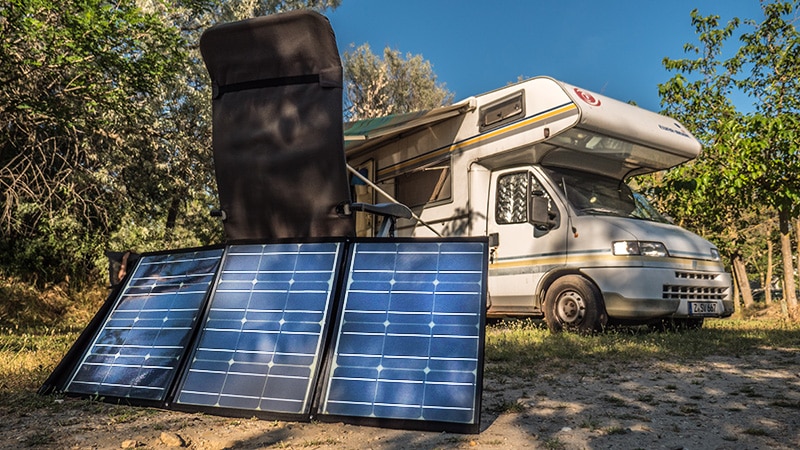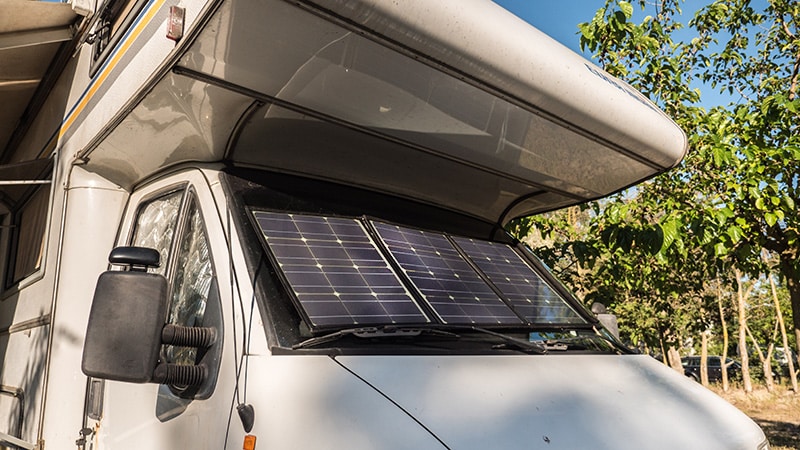If you stay in the same place for a long time without shore power, you know the problem – at some point the power runs out. A self-sufficient power supply is needed. There are three basic options: a solar system, a generator or a fuel cell. While the fuel cell is a fairly new technology in the camping sector and therefore still very expensive, generators are much cheaper but also noisy. The risk of annoying yourself and your neighbours with this noise is high. This article is therefore about solar systems. More precisely, it is about the two possibilities of portable solar systems – the solar suitcase and the foldable solar module.
Inhaltsverzeichnis
What is a solar suitcase?
A solar suitcase is a portable solar system that looks like a suitcase. So here the name says it all. It consists of two solar modules that are connected with a hinge and thus form a kind of suitcase. A solar regulator is usually also integrated, as well as a connection cable for the battery. This regulator converts the current coming from the solar cells into the correct charging current for the connected battery.
What is a foldable solar module?
A foldable solar module is virtually a solar case 2.0. It consists of a very robust bag in which 3 solar modules are incorporated. It has a connection for a cable, to which a solar controller is connected. This further development is much lighter and more flexible. You can also put a solar module like this behind the window, for example. That is very difficult with a bulky solar case.
What is the advantage of portable solar systems?
Compared to permanently installed solar systems on the roof of a motorhome or even a caravan, portable systems have two decisive advantages:
- They can be used immediately and without installation, are therefore independent of the vehicle and can be used in the motorhome, with the car or even in the gazebo.
- They can also always be aligned with the sun. This means that higher electricity yields are possible and the motorhome or caravan can be in the shade while the module is set up in the sun. This is a huge advantage, especially in summer.

Better alignment with the sun
Solar modules deliver the most energy when the sun’s rays fall on them at a 90-degree angle. On a motorhome roof, this can be achieved by mounting the modules so that they can be opened and rotated. The appropriate holders that do this automatically are rare and relatively expensive. If you do it manually, you have to climb around on the roof, which is not without danger. That’s why most modules are simply mounted horizontally. Mobile solar panels, on the other hand, can be set up so that the sun shines on them at a 90-degree angle. They can be easily adjusted during the day and can thus always provide maximum energy. A solar case with 100 watts can therefore replace two horizontally mounted 100 watt solar modules on the roof. For example, we have 2 x 100 watt modules mounted on the roof and also have a foldable solar module with us. This way we can stand in the shade in summer and still produce electricity, and in winter we can charge the batteries with all three modules.
Foldable solar module protects against heat
Another advantage of the foldable solar module is its flexible usability. When we go hiking, for example, we simply place the solar module behind the windscreen from the inside. This way it is protected from theft, produces electricity at the same time and takes away a large part of the sun’s rays. So it keeps the interior cooler. Heat protection, perfect solar orientation and flexibility make a foldable solar module the ideal addition to the two solar modules on our motorhome roof for us. 
Connection to the on-board or starter battery
Our foldable solar module delivers an idle voltage of around 22 volts. If I were to connect it directly to our battery, I would have to constantly monitor the charging process and disconnect the battery as soon as the charging voltage is reached. As soon as the charge goes down again, I would have to reconnect the solar module. That’s annoying. And if I were distracted and forgot to disconnect it, the battery would eventually be destroyed.
A solar controller is required
Therefore, a solar charge controller is clamped between the solar module and the battery. This ensures automatic disconnection and connection of the battery and charges it with the ideal characteristic curve. With such a charge controller, the battery can remain connected permanently without being destroyed. We already have a charge controller in the motorhome due to the solar modules permanently mounted on the roof and have simply connected the portable module there. If you buy a portable solar module, no matter what kind, you must first check whether your existing solar controller can handle the current of another module. Or make sure that a charge controller is included.
How much power do I need?
The most common key figure for solar systems is the maximum power. It is given in the unit Wp. This stands for “Watt Peak”. It indicates the maximum electrical output of a solar module under standard test conditions. In practice, however, this is rarely achieved. However, this figure is well suited for comparison. Our foldable module delivers 100 Wp. This results in a yield of up to 50 Ah in summer in Germany when it tracks the sun. A 100 Ah battery can therefore be half recharged in one day. This makes self-sufficient standing possible for many days when the sun is shining.
The right mobile solar system for the motorhome
There are basically two options for a motorhome. Either a solar case or a foldable solar module. I have compared the respective advantages and disadvantages: [su_table responsive=”yes”]
| Solar case | |
|---|---|
| Advantages | Disadvantages |
| Favourable price | 10 kilogram weight |
| bulky | |
| Foldable solar panel | |
| Advantages | Disadvantages |
| < 5 kilogram weight | expensive |
| flexible | |
| thin | |
[/su_table]
Where can I buy mobile solar systems?
>Our partner Amumot Shop offers mobile solar systems in different variations.
Conclusion
If your budget is very limited, then a classic solar case is right for you. These are available from many manufacturers at very low prices. If flexibility and weight are important to you, then a foldable solar module is right for you.
Cover: (c) Gipfelträumer
Photos: (c) CamperStyle
